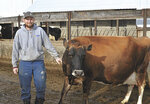


ALMA CENTER, Wis. – Casey Pfaff changes his plans to keep up with the ever-changing dairy industry.
“We were thinking of building a freestall barn in the last four or five years, but actually we bought this second farm for less than what that freestall was going to cost,” Pfaff said.
[[In-content Ad]]
Pfaff, a 2012 graduate of the University of Wisconsin-River Falls, milks 180 cows with his parents, Steven and Kristen, near Alma Center. In February 2020, the family expanded the dairy business with the purchase of a second farm. The Pfaffs had been trying to find the right time to build a freestall barn for many years but decided to change that plan when a neighboring farm came up for sale. They now milk in two barns.
“We had been switching the whole barn out at home for the last 10 years,” Pfaff said. “There were 160 cows over there.”
Pfaff and his father manage the two barns with the help of two employees. Everyone begins the day at the home farm, where they milk 82 cows in a tiestall barn. Once the cows are in and the milkers are on, one employee stays to milk while the other goes to the new barn and milks. Another 98 cows milked in a tiestall barn at the new farm.
Most of the 2-year-old cows are housed in the new barn, where the stalls are smaller. The bigger cows are at the home farm, all housed in the tie stalls. When the family was switching cows, the switch cows were held in a bedded pack. Keeping the younger cows at the new farm now helps manage the ration since the two barns are fed differently.
“The dry matter intake is a lot lower (at the new facility) because the cows are smaller, and we have 15 Jerseys here,” Pfaff said. “They eat 3-4 more pounds of dry matter per cow at the home farm.”
Pfaff’s father does the feeding and the breeding, the employees do the milking, and Pfaff beds the barns, cleans the mangers, takes care of about 200 head of youngstock and feeds calves.
“We have around 400 head total,” Pfaff said. “There are always 30-40 calves to feed.”
All the cows freshen at home, and the calves are housed in hutches. Once they are weaned, the calves are moved to the new farm and raised to about 400 pounds. From there, they return to the home farm for five months, housed in an open-front shed with a bedded pack.
“They move on through until they freshen in,” Pfaff said.
The Pfaffs began planning to build a freestall barn about 2012, but the unstable markets of the dairy industry prevented them from moving forward.
“We were going to go across the road at the home farm where it’s flat, and build everything brand new for 300 cows,” Pfaff said. “But it was barely going to cash flow, and we don’t like to be too tight.”
Three years later, the industry looked a little better, and they thought about building a smaller freestall barn. Again, they put the brakes on the project.
“We opted out of building, and a few years later this farm came for sale,” Pfaff said.
The purchase of a second farm was a way for Pfaff to get some skin in the game, because he purchased the new farm.
“We run it as one farm,” Pfaff said. “It’s their cows and my land.”
The neighboring farm came with 105 acres of tillable land, a house, a bunker, two silos and a machine shed. Pfaff also believes the farm site provides a better opportunity for building a freestall barn when the right time arrives.
“There is a flat spot up on a hill by the pit where we could use natural ventilation to save (money) if that’s where we end up building,” Pfaff said.
Pfaff said managing two barns is a lot of extra work but he believes the decision is paying off.
“It’s more work with your hands because there’s another set of mangers to clean and another set of stalls to bed by hand,” Pfaff sad. “But we have gained some milk, and the cows are doing better.”
Pfaff said morning chores take a little longer because they make sure the cows have time outside, but night chores are easier because they can milk in two barns at once.
With the additional land on the new farm, the Pfaffs now crop 950 acres.
“We are sort of half cash crop and half dairy farmers,” Pfaff said.
They custom hire the corn planting and fall chopping, but everything else is done by Pfaff, his dad and their employees.
Pfaff and his fiancée, Dakota, both enjoy showing cattle when time allows. All their Jerseys are higher-type animals, and a lot of the bigger, higher-producing cows at the home farm have good pedigrees as well.
“It’s my hobby,” Pfaff said. “It’s like my vacation. It’s very rewarding, and we make money off the genetics we sell.”
Pfaff is optimistic about his future in the dairy industry. His goal remains to build a freestall facility when the time and circumstances allow. Although that was the family’s original plan, they felt they could not pass up the opportunity for more land and have made the best of the buildings that came with it.
“For now, it’s more work,” Pfaff said. “But we were so over-crowded back home. We would still like to build a freestall barn in the future. We just don’t know when.”
Comments
No comments on this item Please log in to comment by clicking here